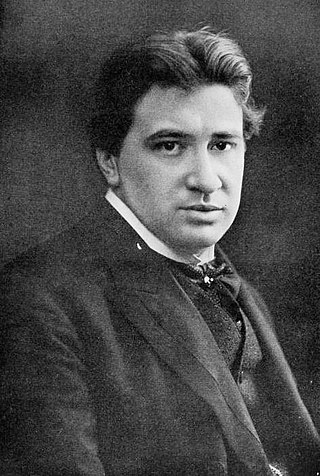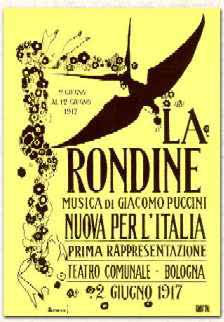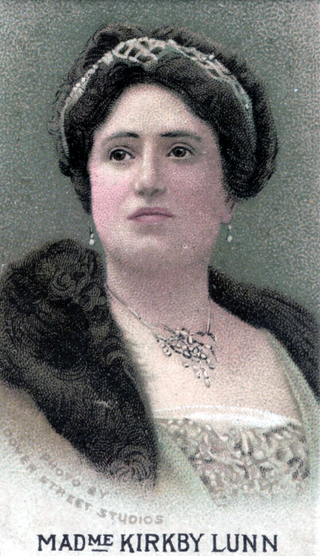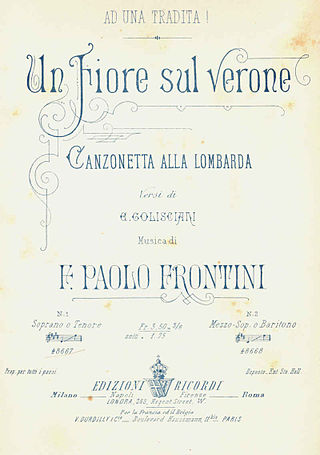
Ermanno Wolf-Ferrari was an Italian composer and teacher. He is best known for his comic operas such as Il segreto di Susanna (1909). A number of his works were based on plays by Carlo Goldoni, including Le donne curiose (1903), I quatro rusteghi (1906) and Il campiello (1936).

Il matrimonio segreto is a dramma giocoso in two acts, music by Domenico Cimarosa, on a libretto by Giovanni Bertati, based on the 1766 play The Clandestine Marriage by George Colman the Elder and David Garrick. It was first performed on 7 February 1792 at the Imperial Hofburg Theatre in Vienna in the presence of Emperor Leopold II.

La rondine is an opera in three acts by Giacomo Puccini to an Italian libretto by Giuseppe Adami, based on a libretto by Alfred Maria Willner and Heinz Reichert. It was first performed at the Grand Théâtre de Monte Carlo in Monte Carlo on 27 March 1917.

I gioielli della Madonna is a opera in three acts by Ermanno Wolf-Ferrari to an Italian libretto by Carlo Zangarini and Enrico Golisciani, based on news accounts of a real event. First performed in 1911, the opera's controversial themes include love between a brother and his adoptive sister, implied criticism of the Catholic Church, and an on-stage orgy.
Iris is an opera in three acts by Pietro Mascagni to an original Italian libretto by Luigi Illica. It premiered on 22 November 1898 at the Teatro Costanzi in Rome. The story is set in Japan during legendary times.

The National Theatre on Max-Joseph-Platz in Munich, Germany, is a historic opera house, home of the Bavarian State Opera, Bavarian State Orchestra and the Bavarian State Ballet.
Graziella Sciutti was an Italian soprano opera singer and later vocal teacher and opera producer.

Cesare Valletti was an Italian operatic tenor, one of the leading tenore di grazia of the postwar era.

Cleofonte Campanini was an Italian conductor and violinist. As a teenager he had a brief but successful career as a concert violinist in Italy and in theaters in Berlin and London. He abandoned the violin in favor of pursuing a career as a conductor, making his conducting debut in 1880 at the age of 20. He established himself as an opera conductor in Parma in the early 1880s, conducting several works which starred his brother, the tenor Italo Campanini.

Louise Kirkby Lunn was an English coloratura contralto. Born into a working-class family in Manchester, She appeared in many French and Italian operas, but was best known as a Wagnerian. In addition to many appearances at the Royal Opera House, Covent Garden, London, she was seen frequently at the Metropolitan Opera, New York in the early years of the 20th century. She died in London, aged 56.

Bernd Weikl is an Austrian operatic baritone, particularly known for his performances in the stage works by Richard Wagner. He also has written books and directed operas.

Enrico Golisciani was an Italian author, born in Naples. He is best known for his opera librettos, but also published a slim volume of verses for music, entitled Pagine d'Album ; many more of his poems intended to be set to music were published in the Gazzetta Musicale di Milano.

Ines Maria Ferraris was an Italian operatic soprano and pianist who sang for more than two decades at La Scala in addition to appearances on the international stage. Although popular in Italy, she had a particularly devoted fanbase throughout South America. A light lyric soprano with a pure and agile voice, Ferraris sang a wide repertoire that encompassed the verismo operas of Puccini, the Italian grand opera of Verdi, and the German operas of Richard Strauss. She is particularly remembered for portraying the role of Lisette in the world première of Puccini's La rondine in 1917.
Lois Jeanette McDonall is a Canadian operatic soprano, especially known for her performances in the operas of Mozart and Donizetti.
Sarah Fox is an English operatic soprano who has performed at several of the world's leading opera houses, notably the Royal Opera House Covent Garden.

Elizabeth Amsden was an American operatic soprano. She had an active international opera career during the early 20th century.

Carolina White was an American operatic soprano who had an active performance career during the first three decades of the 20th century. After beginning her career as a concert soprano in Boston in 1905, she went to Europe where she established herself as a leading soprano in Italy and Switzerland, beginning at the Teatro di San Carlo in 1908. After appearing in major opera houses like La Scala and La Fenice, White left Europe in 1910 to join the roster of artists at the Chicago Grand Opera Company where she was a leading soprano through 1914. After this she was active primarily as a concert soprano up through 1922. She made several recordings for Columbia Records during the second decade of the 20th century.
Friedrich Brodersen was a German operatic baritone. Born in Bad Boll, he studied singing with Heinrich Bertram. He made his professional opera debut in 1900. He created roles in several world premieres during his career, including Pantalone in Ermanno Wolf-Ferrari's Le donne curiose (1903), Count Gil in Wolf-Ferrari's Il segreto di Susanna (1909), Simone Trovai in Erich Wolfgang Korngold's Violanta (1916), Morone in Hans Pfitzner's Palestrina (1917), Sang in Heinrich Rohr's Das Vaterunser, and roles in Paul von Klenau's Sulamith (1913), and Walter Braunfels's Die Vögel (1920).

Alice Zeppilli was a French operatic soprano of Italian heritage who had an active international singing career from 1901 to 1930. The pinnacle of her career was in the United States where she enjoyed great popularity between 1906 and 1914; particularly in the cities of Chicago, New York, and Philadelphia. She was popular in Monte Carlo where she performed frequently from 1904–19 and later worked as a singing teacher after her retirement from the stage. She made only one recording, a phonograph cylinder for Columbia Records consisting of the Gavotte from Jules Massenet's Manon and Olympia's Doll Aria from Jacques Offenbach's The Tales of Hoffmann.
Odyssey Opera is an opera company based in Boston, Massachusetts. Founded in 2013 by Gil Rose, it typically begins its season with a concert performance of a large, rarely heard opera in the fall, continuing the season with fully staged renditions of early, classical, and contemporary opera. The company is known for performing "offbeat, neglected repertoire, with a special nod to those never, or rarely, performed in Boston" and New England.















